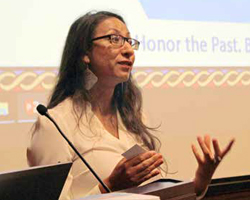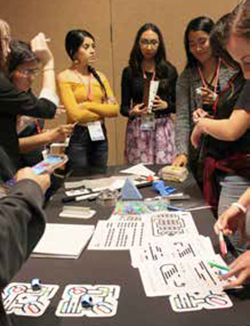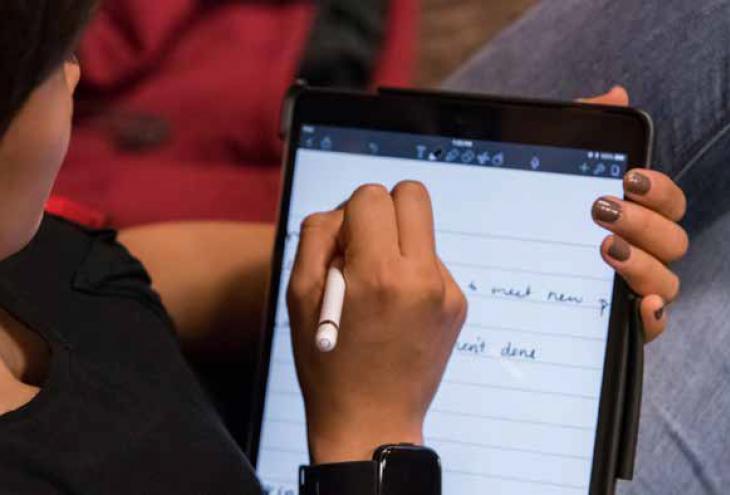National Conference sessions give AISES members, sponsors, and exhibitors an engaging platform for sharing their knowledge, wisdom, and experience. For many attendees, learning from session presenters as they offer information on specialized topics is one of the best parts of a National Conference. In Oklahoma City, there was truly something for everyone in a wide range of sessions. Here’s a sample of just some of them.
5 Steps Guide to Paying for College
Deborah Easter of Wells Fargo Advisors walked attendees through the five classic steps of financing a college education: Step 1. Complete the FAFSA (Free Application for Federal Student Aid); Step 2. Apply for scholarships; Step 3. Estimate and compare total college costs; Step 4. Determine if you need additional money; Step 5. Explore additional financing options. Attendees were busy taking notes as Easter explained what each step entails, and she distributed pamphlets for further guidance on this important topic.
Enigma

Enigma was a notorious electromechanical rotor device used by the Germans from the end of World War I through World War II to put plain text into cipher and decipher encrypted text. The code was first broken by a Polish team of mathematicians in the 1930s. When the Germans were poised to invade Poland, the Poles turned their information over to the British, who set up the top-secret code-breaking team known as Ultra to continue the work. Ultra went on to contribute to Allied victories in all theaters of the war. The Enigma session was led by Paul Marynowski of the NSA, which focuses on making, breaking, and defending today’s codes and ensuring the nation’s cybersecurity. He pointed out that the best technology is useless if the team isn’t employing appropriate processes, giving the example of German submarines communicating via Enigma as the British intercepted the messages. He explained that the Fourth Amendment (protection from unreasonable searches and seizures) is the basis for everything at the NSA in its role as a combat support agency, helping the military protect the country. Marynowski used the Enigma lesson from history to illustrate the kinds of things the NSA does now because he couldn’t speak to specifics of the agency’s current activities. He ended his talk by emphasizing that if you have a tough problem, like today’s cyber threats, the best way to solve it is with a diverse team of creative thinkers with fresh eyes — the NSA knows from everyday experience that diversity works.
How to Become a Successful Chapter
AISES U.S. Senior National Student Representative Hannah Balderas, Canada National Student Representative Brielle Thorsen, and several regional student representatives discussed ways AISES college chapters can attract and maintain members and ensure long-term chapter success. Topics covered included succession planning, hosting a regional conference, event planning, community service, recruitment and retention, and collaboration. Attendees shared their own experiences and offered advice for addressing specific issues fellow chapter leaders are facing, including fundraising and spreading the word about AISES and what the local AISES chapter does. In addition to noting that free, often home-cooked, food is always a draw for meetings and attracting potential new members, the attendees talked about the importance of mentoring, identifying talent within their chapters, and even ways to take advantage of social media to promote their mission. One student explained the steps she takes to help members improve their public speaking skills and build confidence.
IllumiNative: Reclaiming Native Truth
Consultant Crystal Echo Hawk offered an overview of the findings and implications of the Reclaiming Native Truth project, which she co-directed. This $3.3 million, two-year project assessed mainstream perceptions of Native peoples and addressed how to correct inaccurate narratives. The project goal is to both transform public perceptions and advance progress in areas like respect, inclusion, tribal sovereignty, and social justice. She described some of the study findings, like 40 percent of respondents believe that Native Americans no longer exist (Standing Rock has improved this number). Invisibility is a problem, Echo Hawk said, because it contributes to damaging misconceptions: if you can’t connect with someone, you are less likely to be supportive. In another damaging statistic, only 34 percent of Americans believe that Native Americans face discrimination. But the next phase of the project is about taking action, and one big factor driving the narrative is the fact that 87 percent of schools don’t teach about Native Americans post-1900. The good news is that 78 percent of respondents said they are open to learning more, and a new initiative called IllumiNative (illuminatives .org) has been launched to translate the data into action.
Indigeneering STEAM: Integrating Modern Engineering with Indigenous Wisdom to Co-Create a Harmonious and Sustainable Future

How Scientists and Researchers
Can Empower Indigenous
Data Governance
Presenter Deanna Burgart, winner of the 2018 AISES Blazing Flame Award, spoke to her belief that incorporating diverse ideas and perspectives can be a big step toward finding innovative solutions to today’s challenges. She talked about the failure of Canada, her home country, to accept the United Nations Declaration on the Rights of Indigenous Peoples until 2016. That sort of reluctance can stand in the way of progress, she said, as it’s not enough to give lip service to Indigenous people or to consult tribal representatives about a project. Burgart said what is necessary is actually listening to their feedback and being willing to allow what you hear to change plans. The Western view of science, she added, is often at odds with Native spirituality, which can be a barrier for Native students in a classroom. She spoke to the need for indigenization of the curriculum so that Indigenous people can see themselves in it. Across the world Burgart has found that Native people emphasize interconnectedness and closeness to the land. She is working for a world where oil and gas companies will emphasize those things as well and consider the cumulative impact of their projects on the land rather than “silo” their approach.
Indigenous Data Sovereignty: How Scientists and Researchers Can Empower Indigenous Data Governance
Presenter Lydia Jennings began by asking attendees to respond to several questions: What is data? What is data governance? How does your community govern data? How can we engage non-tribal entities to support data governance? She defined data sovereignty as the concept that stored information is subject to laws, and Indigenous data sovereignty as the right of Indigenous peoples and nations to govern the collection, ownership, and application of data, which derives from an inherent right to self-government. Jennings urged reclaiming data sovereignty through governance and decolonizing data. She illustrated the idea that replacing non-tribal entities and norms with tribal is critical through a “data paradigm”: “By Them for Them” is “data about us”; “By Them for Us” is “patronizing”; “By Them with Us” is “rhetoric”; and “By Us for Us” is “Indigenous data sovereignty.” She pointed out that the effort to reclaim data is global, having started with the Maori. The Native Nations Institute at the University of Arizona is active in this area. She concluded by pointing out that there are many supports, including the United Nations, for the rights of Indigenous people to self-determination in data sovereignty. As a scientist Jennings urged attendees to take at least one law class to become familiar with the issues that affect communities and to understand the reciprocal relationship between nation building and data rebuilding.
I-Spy: A Native American CIA Officer’s Story
This session started with the story of TeeCie, a Native American Central Intelligence Agency (CIA) officer and how, despite not being what is typically considered a good student, she became an analyst at the agency. The students in attendance were then encouraged to take part in an activity called “What’s in the Box?” Participants were tasked with using their analytical skills, as well as the clues provided to each of five groups, to not only determine from afar what was hidden in a box placed at the front of the room but also present their findings, explaining their level of certainty and why they reached that particular conclusion. The analysis exercise encouraged being brave and supporting your peers. The students were instructed that it’s OK to say you don’t know something, but it’s still important to add value, collaborate, and draw on your expertise. All five groups were able to piece together the fragmented information and correctly determine that the box held a compass.
Language Preservation: Indigenize Your Career Field
This popular session was presented by Alaina Maker, Osage, who teaches 19 classes a week. She talked about how Native languages can follow the example of Cherokee, where native speakers are working with Google on translating text to speech. She emphasized the need for Indigenous people in organizations like Microsoft, Google, and Apple to fight for the preservation and proliferation of Native languages, saying, “We don’t live in two worlds; we want to indigenize the world around us.” One attendee pointed to the fact that most proficient speakers are elders, emphasizing the urgent need to sit and talk with them to learn the language. The session then broke into smaller groups where participants brainstormed ideas on how to incorporate traditional languages in everyday life.
Picking Your Top College
This session offered advice to pre-college students on how to make the best use of the research behind the Top 200 Colleges for Indigenous Students roster, published in the annual Winds of Change Special College Issue. Presenters Karen English, Amy Norcross, and Kristen Goodfriend of the magazine staff explained how to use the data and outlined some important data points to look for, like graduation rate, costs, class size, and campus resources for Native students. Each attendee was given a copy of the current College Issue for reference.
A Road Map to a Career in STEM: Planning the Routes, Discovering the Detours, and Locating Roadside Assistance
Dr. Susan VanderKam and Meredith LaSalle-Tarantin, both from Princeton University, discussed ways to make the journey to and through college less intimidating. After providing an overview of career options available in each STEM field, they mapped out a general path to those careers, highlighting what training is required for specific professions and noting that the way may not be as straightforward as students expect or hope. Obstacles — such as lack of money, health issues, transferring, or even changing majors — will occur, but they can be overcome. Help is available, in the form of academic and residential advisors, professors’ office hours, online academic resources, and campus resource centers for careers, health, social issues, and even writing. Attendees were encouraged to develop a basic career map that works for them, but understand that they may need to seek alternate routes as well as the importance of taking advantage of the tools and services available to help them achieve success.
Smart Girls Rock

During this interactive session, sponsored by 3M and hosted by Octavio Rodriguez, Eric Daugherty, Todd Ambo, Sarah Gumina, Renee Peterson, and Juliana Biederman, attendees were encouraged to rotate among three stations and then determine whether the experience changed any of their original views on STEM and STEM careers. One station provided an overview of the STEM subject fields and possible jobs in each. At a second station, attendees learned about opportunities available at 3M, as well what the two employees hosting the station did each day at work and how they reached their current positions. The third station allowed for hands-on learning about Ozobots — pocket-sized robots that can read color patterns and provide a creative introduction to coding — as well as the technology behind car-wrap films, reflective signage, gripping tape, and even super-strong tape that actually can be used to construct buildings.
So You Want to Be a Hacker?
(Introduction and Advice for a Career in Cybersecurity) Presenter Anthony Marquez addressed his goal of removing obstacles to entering the field of cybersecurity by emphasizing that traditional culture is a strength. After giving attendees an overview of the field of cybersecurity, he talked about his own experience and offered career advice. He pointed out that the time you spend on the job is what you get paid for, but the time you spend off the job is what makes you successful — success is up to you. He explained the danger of “imposter syndrome” by illustrating his own experience as a student at Stanford, when he doubted the admission officers’ decision to admit him. That doubt undermined his confidence. Instead, Marquez urged students to have a better experience by focusing on proving they belong. He reminded attendees to live in balance and harmony and keep up their technical skills, even as they advance in their careers.














